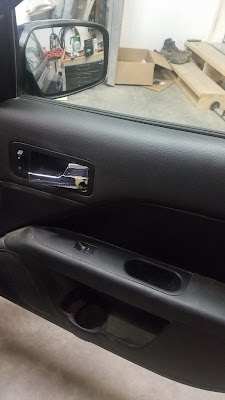Ms. Fix-It
This is a broken car door handle.
It's been a thorn in my side for a few years now. Why? Well, at one point I would have said it was too expensive to fix and therefore it was very low priority.
Recently, however, I needed to replace my front brakes. Let's talk about things that are too expensive.
Egads.
This time, though, I realized I had the time to take care of it myself, and after a fair bit of research (that is, watching videos on YouTube) I realized I could probably do my brakes myself. A few parts, a couple hours, and voila -- brakes!
Which is what brings me here today.
You see, I'm not really a DIY person (whether that was car stuff or other stuff) and there are a lot of things out there that I used to only purchase. Over time, however, I've realized how much of it I can take care of myself in a shorter time for a lot less money, whether it's fixing something or making something from scratch.
I'll admit, I have an unfair advantage: I am unintimidated by mechanical things and I have no fear of pushing buttons. This isn't knowledge of mechanical things, mind you -- it's just a lack of fear. It's not true for everyone. As I start walking through my usual process, you might not get past step two and that is just fine. But if you can keep going, it's strangely rewarding to know that you took care of it yourself.
So here we go.
With any luck, this is easy. ("My door handle is clearly broken" or "I need new brake pads" or "I want a coffee table.") If the problem is unidentifiable, take it to a professional -- this is where "random clunking noises" or "something is on fire" often falls.
Seriously, everything is on YouTube. If something on your car has broken, someone else has already dealt with it. If you've decided you want fancy rock work done in your bathroom, someone has instructions out there on how to put that up. It's all there.
Read whatever tutorials and watch whatever videos you find from start to finish. You'll know if you can deal with it or if you want to invest the time. If you can, proceed to the next step.
Sounds self-explanatory, right? Don't skip this step.
And for crying out loud, be realistic. Whatever instructions you found, make sure you at least double the expected time frame. Triple it if you haven't done anything like this before.
It's not that scary.
Okay, fine.
Take notes, keep track of parts, and take pictures along the way if it helps. I've labeled things with sticky notes as I've gone along if there were enough parts. I'll take before and during pictures as reference points so I don't cross wires when I put stuff back together. That kind of thing.
I mean, it's a long standing joke, but you won't like the panic when you get done and have a new "spare" part sitting there, mocking you.
Seriously, removing door panels was a lot more muscle work than I expected.
No, really.
This is more important when you're making something new. Do yourself a favor and don't leave a project half-finished for six months. The guilt is ridiculous. (In related news, I still have some random wood that's supposed to be a bench.)
I like this step.
It's been a thorn in my side for a few years now. Why? Well, at one point I would have said it was too expensive to fix and therefore it was very low priority.
Recently, however, I needed to replace my front brakes. Let's talk about things that are too expensive.
Egads.
This time, though, I realized I had the time to take care of it myself, and after a fair bit of research (that is, watching videos on YouTube) I realized I could probably do my brakes myself. A few parts, a couple hours, and voila -- brakes!
Which is what brings me here today.
You see, I'm not really a DIY person (whether that was car stuff or other stuff) and there are a lot of things out there that I used to only purchase. Over time, however, I've realized how much of it I can take care of myself in a shorter time for a lot less money, whether it's fixing something or making something from scratch.
I'll admit, I have an unfair advantage: I am unintimidated by mechanical things and I have no fear of pushing buttons. This isn't knowledge of mechanical things, mind you -- it's just a lack of fear. It's not true for everyone. As I start walking through my usual process, you might not get past step two and that is just fine. But if you can keep going, it's strangely rewarding to know that you took care of it yourself.
So here we go.
Step One: Identify the problem/task.
With any luck, this is easy. ("My door handle is clearly broken" or "I need new brake pads" or "I want a coffee table.") If the problem is unidentifiable, take it to a professional -- this is where "random clunking noises" or "something is on fire" often falls.
Step Two: Do some research.
Seriously, everything is on YouTube. If something on your car has broken, someone else has already dealt with it. If you've decided you want fancy rock work done in your bathroom, someone has instructions out there on how to put that up. It's all there.
Read whatever tutorials and watch whatever videos you find from start to finish. You'll know if you can deal with it or if you want to invest the time. If you can, proceed to the next step.
Step Three: Make sure you have the parts and tools needed.
Sounds self-explanatory, right? Don't skip this step.
Step Four: Block out the time.
And for crying out loud, be realistic. Whatever instructions you found, make sure you at least double the expected time frame. Triple it if you haven't done anything like this before.
Step Five: Take a deep breath and get moving.
It's not that scary.
Step Six: Acknowledge that sometimes it IS that scary.
Okay, fine.
Step Seven: Stay organized.
Take notes, keep track of parts, and take pictures along the way if it helps. I've labeled things with sticky notes as I've gone along if there were enough parts. I'll take before and during pictures as reference points so I don't cross wires when I put stuff back together. That kind of thing.
I mean, it's a long standing joke, but you won't like the panic when you get done and have a new "spare" part sitting there, mocking you.
Step Eight: Realize that the step in the process that you thought was going to be the shortest and easiest one is the longest one.
Seriously, removing door panels was a lot more muscle work than I expected.
Step Nine: Don't be afraid to call for reinforcements if things get wonky.
Step Ten: Keep going.
This is more important when you're making something new. Do yourself a favor and don't leave a project half-finished for six months. The guilt is ridiculous. (In related news, I still have some random wood that's supposed to be a bench.)
Step Eleven: Abruptly realize you're done and that wasn't so bad.
I like this step.
I don't think I mentioned that both door handles were broken. Seriously, I should have done this years ago.
Step Twelve: Bask in the moment when you get to toss an old bad part.
Step Thirteen: Take a moment to reflect and add up your own costs.
Was it worth it? Did you save money? Was your time well-spent? Did you learn something new? Was it, "I hate cars and never want to do this again?"
The fun part is ... this can apply to a lot of things. This has been my process for everything from that brake work to sewing a dress to properly cooking a turkey to making my own cleaning solutions. There have been times where I've gotten done and realized it wasn't worth the effort -- so I never did it again. And there have been multiple projects where step eight bit me and I got stuck there.
But hey, I've learned something every time.
Especially today ... when I could hit the lock button on my keys and it actually worked. Wonderful.






Comments